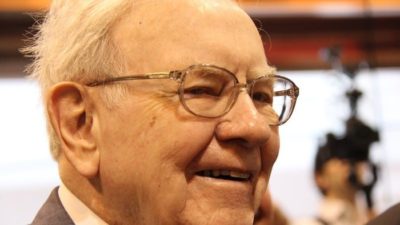Warren Buffett is arguably the world's greatest investor. His US$30b fortune certainly makes him one of the world's richest men.
But alongside the enormous wealth, Buffett's reputation is enhanced by the annual letters he writes to the shareholders of his investment vehicle, Berkshire Hathaway. Freely available to all, the shareholder letters outline the investment strategy that has served him well for over 30 years.
Buffett's stock picking roots lay with Ben Graham. After working two years for Graham in the late 1950s, Buffett began his own investment partnership using Graham's short-term "value" principles. Between 1957 and 1969, Buffett's investments grew at a compound annual rate of 29.5%, crushing the Dow's return of 7.4%.
However, over time, Buffett's investment strategy gradually evolved. Prompted by Philip Fisher and his business partner Charlie Munger, Buffett gradually shifted his share market focus towards business perspective investing.
In essence, Buffett concluded that holding superior businesses for the long-term would lead to more sustainable stock market success than the purchase of poor — but cheap — businesses.
The switch in styles helped Berkshire Hathaway record an average annual gain of 20.3% between 1965 and 2009, a performance that has outstripped the S&P 500 by 11% per annum.
Long-term buy and hold
Buffett's long-term buy and hold investment style is encapsulated in this quote:
"Your goal as an investor should simply be to purchase, at a rational price, a part interest in an easily-understandable business whose earnings are virtually certain to be materially higher five, ten and twenty years from now. Over time, you will find only a few companies that meet these standards – so when you see one that qualifies, you should buy a meaningful amount of stock. You must also resist the temptation to stray from your guidelines: If you aren't willing to own a stock for ten years, don't even think about owning it for ten minutes. Put together a portfolio of companies whose aggregate earnings march upward over the years, and so also will the portfolio's market value."
The above paragraph contains a handful of significant points that form the cornerstones of Buffett's philosophy:
* 'An easily-understandable business'
One of Buffett's key principles is the "circle of competence". In essence, limit your stock market efforts to a handful of industries that you understand. The greater your understanding of a business, the more likely you'll recognise investment opportunities and danger signs.
It's no coincidence that Buffett has liked companies such as Coca Cola and Gillette, two consumer-facing businesses whose products are readily understandable to almost everyone. As Buffett writes:
"Investors should remember that their scorecard is not computed using Olympic-diving methods: Degree-of-difficulty doesn't count. If you are right about a business whose value is largely dependent on a single key factor that is both easy to understand and enduring, the payoff is the same as if you had correctly analysed an investment alternative characterized by many constantly shifting and complex variables."
"What counts for most people in investing is not how much they know, but rather how realistically they define what they don't know. An investor needs to do very few things right as long as he or she avoids big mistakes."
* '…whose earnings are virtually certain to be materially higher five, ten and twenty years from now'
With the future always uncertain, how can an investor pinpoint companies whose profits will be 'materially' higher in the years to come? Buffett's trick is to look for businesses that already have competitive strengths and — crucially — operate in areas that are not susceptible to major change:
"You will see that we favour businesses and industries unlikely to experience major change. The reason for that is simple: We are searching for operations that we believe are virtually certain to possess enormous competitive strength ten or twenty years from now. A fast-changing industry environment may offer the chance for huge wins, but it precludes the certainty we seek."
More than anything, Buffett looks for companies that have a sustainable competitive advantage:
"The key to investing is not assessing how much an industry is going to affect society, or how much it will grow, but rather determining the competitive advantage of any given company and, above all, the durability of that advantage. The products or services that have wide, sustainable moats around them are the ones that deliver rewards to investors."
* 'A rational price'
While Buffett's investing style may have progressed, he still remains faithful to Graham's core principle: the margin of safety:
"We insist on a margin of safety in our purchase price. If we calculate the value of a common stock to be only slightly higher than its price, we're not interested in buying. We believe this margin-of-safety principle, so strongly emphasized by Ben Graham, to be the cornerstone of investment success."
But how does Buffett assess the value of a common stock? Rather than traditional short-term ratios, he focuses on the cash that a company can generate throughout its remaining life:
"The value of any stock, bond or business today is determined by the cash inflows and outflows – discounted at an appropriate interest rate – that can be expected to occur during the remaining life of the asset."
"Common yardsticks such as dividend yield, the ratio of price to earnings or to book value, and even growth rates have nothing to do with valuation except to the extent they provide clues to the amount and timing of cash flows into and from the business."
* 'You will find only a few companies that meet these standards'
Great, straightforward businesses rarely sell at attractive prices. So much so that Buffet has bought into very few long-term share investments in the past 35 years.
Concentrating just on his common stock portfolio, Buffett never owned more than 10 different shares during the 1990s. Furthermore, a third of the portfolio was generally been invested in just one holding. In fact, Buffett actually states that greater diversification can actually increase your risk:
"If you are a know-something investor, able to understand business economics and to find five to ten sensibly-priced companies that possess important long-term competitive advantages, conventional diversification makes no sense for you. It is apt simply to hurt your results and increase your risk. I cannot understand why an investor of that sort elects to put money into a business that is his 20th favourite rather than simply adding that money to his top choices – the businesses he understands best and that present the least risk, along with the greatest profit potential. In the words of the prophet Mae West: 'Too much of a good thing can be wonderful.' "
Words of wisdom
While many authors have tried to distil Buffett's techniques into step-by-step books, there's no better source of Buffett's wisdom than his annual shareholders letters. Going back some 35 years, they're at the top of the list for those wishing to learn about successful investing.








